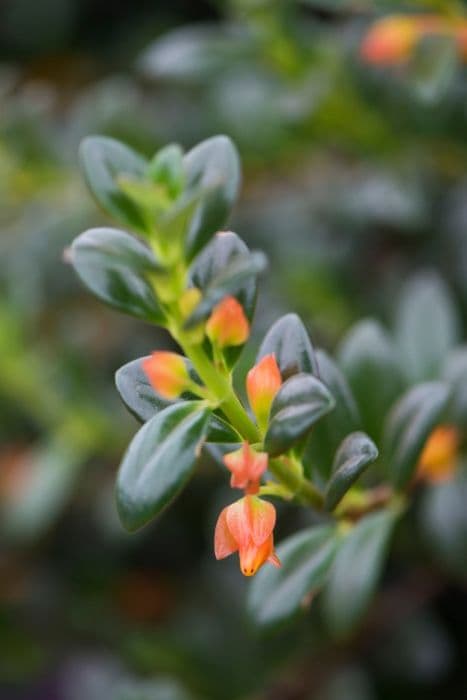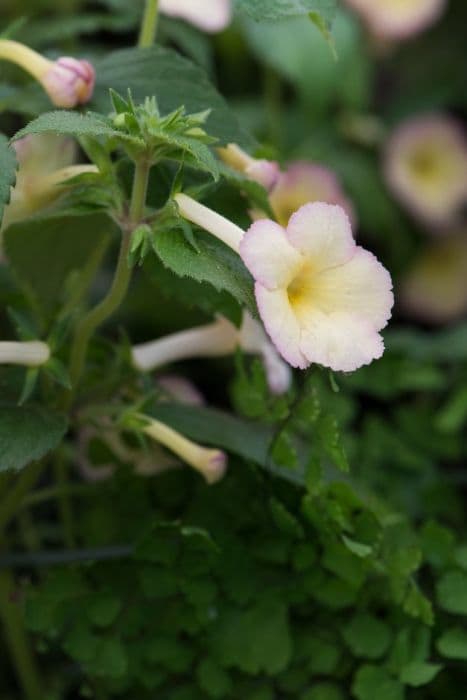African violet Streptocarpus ionanthus



ABOUT
African violets are small, compact houseplants that typically reach a height of 6 to 8 inches and have a spread of 8 to 12 inches.
The leaves are generally oval-shaped, measuring around 2 to 3 inches in length.
African violets produce clusters of dainty flowers that can range in size from 1 to 2 inches in diameter, held above the foliage on slender stems. Their small size makes them ideal for indoor cultivation and display in containers or hanging baskets.
About this plant
 Names
NamesFamily
Gesneriaceae
Synonyms
Usambara violet, African violet, Saintpaulias
Common names
Saintpaulia tongwensis, Saintpaulia ionantha, Streptocarpus ionanthus
 Toxicity
ToxicityTo humans
African violets are generally considered non-toxic to humans. They are safe to touch, handle, and have around children and adults.
However, it's important to note that individual sensitivities or allergies can vary, and some individuals may experience mild skin irritation or allergic reactions.
If you have known allergies to plants or suspect sensitivity, it's best to handle African violets with caution and seek medical advice if any adverse reactions occur.To pets
African violets are known to be non-toxic to cats, dogs, and most common household pets.
Ingesting or chewing on the leaves or flowers of African violets is generally not considered harmful to animals.
However, as with any plant, it's always a good idea to monitor your pets' behavior and prevent them from excessively consuming plant material. If you suspect your pet has ingested a large amount of African violet or shows any signs of discomfort, it's recommended to consult a veterinarian for further guidance.
 Characteristics
CharacteristicsLife cycle
Perennials
Foliage type
Evergreen
Color of leaves
Green
Flower color
Various
Height
Up to 8 inches
Spread
Up to 12 inches
Plant type
Herb
Hardiness zones
10
Native area
Eastern Africa
Benefits
 General Benefits
General BenefitsOrnamental Beauty: African violets are prized for their delicate and colorful flowers, which can brighten up any indoor space. They come in a wide variety of shades, including purples, pinks, whites, and blues, making them a popular choice for adding aesthetic appeal to homes and offices.
Compact Size: African violets have a compact growth habit, making them ideal for small spaces or for those who prefer plants that don't take up much room. Their small size allows them to be easily grown in containers or as hanging plants, adding beauty to even the tiniest of spaces.
Indoor Adaptability: African violets are well-suited for indoor environments and can thrive in the relatively stable conditions found in homes and offices. They can tolerate lower light levels and prefer slightly warmer temperatures, making them a popular choice for indoor gardening.
Low Maintenance: African violets are relatively low-maintenance plants, requiring moderate care compared to some other houseplants. With proper watering, light, and occasional fertilization, they can thrive for extended periods without much fuss. This makes them a great choice for both novice and experienced gardeners.
Propagation Ease: African violets are relatively easy to propagate, allowing gardeners to create new plants from leaf cuttings or by separating offsets from the main plant. This makes them a rewarding choice for those interested in plant propagation and expanding their plant collection.
Long-Lasting Blooms: African violets can produce blooms for several weeks to months at a time, providing a long-lasting display of flowers. Their ability to consistently produce new buds and flowers adds to their appeal as indoor plants that bring ongoing beauty to the surroundings. Medical Properties
Medical PropertiesAfrican violets are primarily grown as ornamental houseplants and are not commonly associated with significant medical properties.
 Air-purifying Qualities
Air-purifying QualitiesAfrican violets are not widely recognized as air-purifying plants.
 Other Uses
Other UsesNatural Dye: African violets can be used to create natural dyes for fabric or yarn. The flowers can be simmered in water to extract their color, which can range from pale purples to pinks. This natural dye can be used to add unique hues to textiles or for creative crafting projects.
Edible Decoration: While African violets are not typically consumed as food, their colorful flowers can be used as decorative elements for cakes, pastries, or other culinary creations. Ensure that the flowers are pesticide-free and intended for consumption before using them in food preparation.
Artistic Inspiration: The unique shape, colors, and delicate features of African violet flowers can inspire artists and designers. They can serve as subjects for botanical illustrations, paintings, or even as motifs in jewelry or fabric patterns.
Interesting Facts
 Feng Shui
Feng ShuiIn Feng Shui, African violets are believed to bring positive energy, harmony, and good luck to the home. Here are a few ways to incorporate African violets in Feng Shui practices:
Placement: Place African violets in areas associated with the Wood element, such as the East or Southeast sectors of your home or specific rooms. These areas are believed to enhance growth, vitality, and abundance.
Balance and Harmony: African violets can be used to create a sense of balance and harmony in a space. Use them in pairs or groupings to promote harmonious energy flow and create a visually pleasing arrangement.
Colors: African violets come in various colors, and each color has its own Feng Shui significance. For example, purple is associated with spirituality and abundance, while pink represents love and relationships. Choose the color that aligns with your intentions and the energy you want to enhance in your space. Zodiac Sign Compitability
Zodiac Sign CompitabilityIn astrology, the compatibility of plants with zodiac signs is not a widely established or recognized practice.
 Plant Symbolism
Plant SymbolismAfrican violets are often associated with sentiments such as love, affection, and charm. They are symbols of grace, beauty, and delicacy. Additionally, African violets are believed to represent growth, nurturing, and the ability to thrive in challenging conditions. The symbolism of African violets can vary across cultures and personal interpretations.
 Water
WaterAfrican violets prefer slightly moist but not waterlogged soil. As a general rule, water them when the top inch of the soil feels dry to the touch. The frequency of watering can vary depending on factors such as temperature, humidity, pot size, and soil type. On average, watering once or twice a week is often sufficient, but always adjust based on the specific needs of your plant.
Water African violets from the bottom to avoid wetting the leaves, which can lead to leaf spots or rot. Place the pot in a shallow tray or saucer filled with water and let the plant absorb moisture through the drainage holes in the bottom of the pot. Allow the plant to soak up water for about 30 minutes, then remove it from the tray and let any excess water drain away. Light
LightPlace African violets in a location where they receive bright, filtered light. Avoid exposing them to direct sunlight, as it can scorch their leaves. East or north-facing windows are generally suitable for providing the right amount of light.
 Temperature
TemperatureAfrican violets are generally not cold-tolerant and should be kept away from cold windows or areas prone to chilly drafts.
The ideal temperature range for African violets is between 65 to 75°F (18 to 24°C). They thrive in temperatures similar to those preferred by humans, avoiding extremes on either end.
Avoid placing African violets near drafts, heating vents, or air conditioning units that can cause temperature fluctuations. Sudden changes in temperature can stress the plants and affect their growth. Pruning
PruningPruning African violets helps maintain their shape, encourage bushier growth, and remove any diseased or damaged leaves.
 Cleaning
CleaningAs needed
 Soil
SoilIt's recommended to use a commercially available African violet potting mix or create your own blend. African violet soil mixes often contain a combination of peat moss, perlite, vermiculite, and other organic materials to provide good drainage while retaining moisture.
African violets thrive in slightly acidic soil with a pH range of around 5.5 to 6.5. This slightly acidic environment allows the plants to efficiently absorb nutrients from the soil. Repotting
RepottingRepotting African violets is typically done when the plant outgrows its current pot or when the soil becomes compacted and doesn't drain well anymore.
African violets generally require repotting every 8 to 12 months, depending on their growth rate and the size of the pot. However, if the plant is healthy and not showing signs of being root-bound, you can leave it undisturbed for longer.
When repotting, gently remove the African violet from its current pot, carefully loosen the root ball, and place it in a slightly larger pot with fresh, well-draining soil. Avoid burying the crown of the plant (where the leaves emerge) too deeply. Humidity & Misting
Humidity & MistingAfrican violets generally thrive in humidity levels between 40% to 60%. This range provides enough moisture in the air to support healthy foliage and flowering without promoting excessive moisture or humidity-related issues.
 Suitable locations
Suitable locationsIndoor
All year round
Outdoor
Can be grown all year round in the right climate
Hardiness zone
11-12 USDA
 Life cycle
Life cycleGermination and Seedling Stage: African violets can be propagated from seeds or through other methods such as leaf cuttings. During the germination stage, which typically takes around 2 to 3 weeks, the seeds sprout and develop into seedlings. This stage is usually carried out in a controlled environment, such as a seed tray or small pots with a suitable growing medium.
Vegetative Growth Stage: After the seedlings develop, they enter the vegetative growth stage. This stage involves the growth of leaves, stems, and roots. African violets produce a rosette of leaves from the center of the plant, with new leaves emerging from the center as the outer leaves mature. The plant focuses on establishing a healthy root system and developing foliage during this stage.
Flowering Stage: Once African violets reach maturity, they enter the flowering stage. The exact timing of flowering can vary depending on various factors such as the age of the plant, growing conditions, and cultivar. African violets typically bloom for several weeks to several months. They produce clusters of delicate, colorful flowers that can range from shades of purple, pink, white, and other variations. The flowering stage can occur multiple times throughout the year, with periods of rest in between.
Resting Stage: After a flowering period, African violets enter a resting stage. During this time, the plant may pause in blooming and focus on replenishing its energy reserves. The resting stage allows the plant to recover and prepare for the next growth cycle. It's important to provide appropriate care, such as adjusting watering and fertilization, during this period to support the plant's health. Propogation
PropogationPropogation time
Spring - summer
Leaf cuttings: Select a healthy leaf from the parent plant and remove it with a clean, sharp knife. Dip the cut end into rooting hormone and plant it into a moist, sterile soil mix. Cover with a plastic bag or container to maintain humidity, and place in a warm, bright location. After a few weeks, the cutting should start to root and develop into a new plant.
Division: Carefully remove the parent plant from its pot and separate the crowns or "babies" that have formed around the base. Plant each crown into a new pot with fresh soil mix and water thoroughly.
African violets can be propagated any time of year, but the best time is in the spring or early summer when the plant is actively growing.
 Pests
PestsSpider mite, Thrips, Mealybug, Aphid
 Diseases
DiseasesRoot Rot, Powdery mildew









